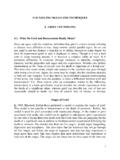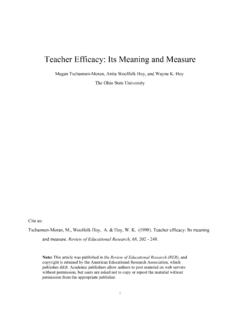Transcription of Child Sexual Exploitation Support in Children’s Homes
1 Child Sexual Exploitation : Support in children s residential Homes Research report December 2016 Ivana La Valle and Berni Graham with Di Hart Acknowledgements We would like to thank staff in the residential Homes included in the study for giving up their time to take part in the research. Our thanks also go to: Sylvia Potter for carrying out the literature searches and proof reading the report; Dr Isabelle Brodie, who peer reviewed the draft report; and, at the DfE, Afia Hassan, Brittany Gavit and Gail Peachey. 2 Contents Executive summary 5 1 Introduction 9 Research aims 9 Methodology 9 The evidence on CSE practice in residential care 10 Report outline 11 2 Purpose of CSE interventions in residential care 12 The needs of children affected by CSE 12 The aims of intervention 14 children s outcomes 15 Conclusion 21 3 Supporting children affected by CSE 23 Framework underpinning CSE work 23 The secret is in the matching 26 Building the foundation 28 Package of services 32 Conclusion 36 4 What Homes found to be effective 38 A clear framework 38 Staffing 38 Interagency work 40 children s involvement 42 Working effectively with families 44 Effective time frames 46 3 Effective transition
2 Planning 47 Conclusion 48 5 Conclusion 50 Approaches to supporting children affected by CSE 50 Benefits of residential care 52 What works well? 53 In conclusion 54 References 55 Appendix A Search strategy 59 Appendix B Summary of evidence reviewed 62 4 Executive summary While Child Sexual Exploitation (CSE) has attracted considerable attention in recent years and has highlighted how residential children s Homes can be targeted by CSE perpetrators, little is known about the tailored Support provided to children affected by CSE who are placed in residential care. This study was commissioned to start filling this evidence gap. More specifically, the study aimed to: identify approaches already used in children s Homes to Support children who have been sexually exploited or are at risk of Sexual Exploitation .
3 Explore the perceived benefits and impact of the tailored Support that has been offered. distil what seems to work well in supporting children affected by CSE in residential care and offer conclusions on the benefits of sharing the learning more widely. Evidence for the study was gathered through: a rapid review of the international evidence on CSE Support ; interviews with ten residential children s Homes in England that were known for their CSE expertise and high-quality provision; and case studies in four of these Homes involving eight children affected by CSE. What are the needs of children affected by CSE The literature we reviewed and the Homes in our study showed that children affected by CSE placed in residential care were very vulnerable and had a range of complex, high-level needs.
4 These children were typically highly traumatised due to CSE, compounded in some cases by other traumatic experiences common among children in residential care, such as neglect, and physical and domestic violence. Traumatic experiences meant that these children were very vulnerable, with substance abuse, self-harm, depression, violent behaviour, low self-esteem, and sleep and eating disorders being common. The chaos that typically characterised these children s lives before they entered residential care was also reflected in: disengagement from education; lack of positive activities; lack of positive friendships and Support networks; and health issues ranging from sexually transmitted diseases to very unhealthy lifestyles.
5 While many children affected by CSE were reported to have been in the care system from an early age, some had entered care as adolescents. It should be noted that our study focused primarily on girls; the extent to which boys in residential care affected by CSE may face different or additional issues would be worth exploring further. 5 Perceived benefits of the care and interventions offered All the Homes in our study and the literature concurred on the key purpose of interventions with children affected by CSE, that is, removing risks and building resilience. Key expected outcomes included: improved insight; a sense of self-worth; higher aspirations; positive relationships; educational achievements; positive interests; effective communication skills; and improved health and wellbeing.
6 As well as being valuable in their own right, these outcomes were seen as contributing to teaching children to recognise and manage risks, and build resilience. Timeframes for making progress in these different areas were very individualised, and there were periods of progress as well as remissions , but the ultimate aim was for CSE risks to be removed or much reduced so children could be children again. There was a great deal of commonality between the expected outcomes identified in the literature and outcomes reported by the Homes in our study, suggesting that these are likely to be suitable core outcomes to monitor the effectiveness of CSE interventions. However, while in the literature, data on some key outcomes were often collected systematically using standardised measures ( self-esteem and trauma inventories), in the Homes , information on the progress children made in relation to different outcomes was based mainly on non-systematic and unstructured observations by staff.
7 Furthermore, while the literature identified the need to collect data on long-term outcomes to assess the sustainability of the progress achieved in residential care, none of the Homes collected information on children s outcomes after they left the setting. T herefore, while Homes reported positive outcomes for children affected by CSE, systematic evidence to confirm these benefits and their sustainability is generally lacking. Approaches used to Support children affected by CSE Many of our findings on what underpins effective practice in relation to CSE are in line with what was found in a recent review of residential care in England. For a residential care placement to work, it must have a clear purpose, a theoretical framework and an evidence base to guide practice, a model that shapes every aspect of residential care practice.
8 The question is: should this model be the same as that used for all children with complex and high-level needs, or does it need to be a different model specifically developed to work with CSE? The evidence does not indicate the need to develop a separate CSE model from scratch . All the models identified in the literature and used by Homes in the study were used for all children with complex and high-level needs. Refinements made for CSE work were mainly reflected in the tailored package of Support provided ( CSE education programmes, measures to prevent absconding), rather than the core principles underpinning the model of practice. S pecific CSE issues to consider in providing Support to these children include the tools used to carry out CSE risk assessments and the structural features of a placement that may be more suitable for these children .
9 However, 6 there is little robust evidence to assess what ways are effective in dealing with these issues: A range of tools has been developed to carry out CSE risk assessments, but it was not clear what evidence was used to develop these tools and the extent to which they had been tested. children affected by CSE were believed to do better in very small, single-sex units, although these assumptions have not been tested and we do not know if they hold for both sexes. There is a widely (but not unanimously) held assumption that removing children affected by CSE from their community and placing them in very remote areas helps to keep them safe, but there is no evidence to Support this. In addition, more guidance on what Homes can legally do to prevent children from running away may help in using resources more effectively.
10 The line between ensuring children s safety and restricting their liberty was a very fine one, and a considerable amount of staff time was spent on ensuring that Homes stayed on the right side of the line. The package of Support provided to children affected by CSE seems to reflect the range of complex needs that these children had. To a large extent, these would be the kind of services ( education, health, recreational activities, therapy) provided for those suffering from trauma. In addition, specific CSE educational programmes were being delivered. As the number of CSE tools and educational programmes is growing quickly, it would seem helpful to provide Homes with advice on which of these tools and programmes have been evaluated and how effective they are in different circumstances.
















